Topic: Canadian Militia

The Militia Under Fire
The Toronto Daily Mail, 2 February 1893
As a rule the British general who settles in Ottawa as the commander of the Canadian forces opens his regime with a flattering description of his army and closes it with a deadly fire all round. It has sometimes been said that the changed attitude towards the country's defenders has resulted from a very slight circumstance. Sir Selby Smyth, for example, is reported to have lost confidence in the military because he was saluted by a subordinate with an everyday "how do?" instead of the regulation movement; and General Luard, after a quarrel about a towel, is alleged to have suffered his respect for the soldier-citizenry to diminish.
But possibly these trivial yet suggestive affairs were not the actual causes of the official outbursts. The various general may have found after a brief experience that there was a weakness in the organization and equipment of the militia that Ministerial responsibility was not sufficiently prompt to repair.
General Herbert is pursuing altogether different tactics to those adopted by his predecessors. He is commencing with an assault, in the hope, no doubt, that he will be able to terminate his command with a well-earned eulogy. The General's first report upon the militia was a severe criticism of the entire establishment. He pointed out, first, that the permanent corps were composed too largely of recruits and that the instruction these men received was too frequently wasted, seeing that they retired to make room for raw men after a very brief experience in the regular corps.
Then he turned his attention to the militia. He mentioned that the rural battalions suffered by comparison with the city corps, that their instruction was not efficient, and that the money voted for drill instruction went for other military purposes that ought to be separately provided for. The equipment moreover was inferior and the physique of the men, in some cases, "wretched."
This year's report is not less sweeping than that of last year; but it deals chiefly with the materials upon which the men have to work. Everything in use is obsolete and bad. The stores are filled with old and worn out material. The clothing is issued under an imperfect system; the leather of which the boots are made is of the consistency of paper. The rifles are useless; the ammunition manufactured at the Quebec cartridge factory is antiquated. The soldiery will not stand a twelve days' drill. The rifle ranges are, with one honorable exception, too small for practice with a modern rifle. The great guns are ancient, and the gun carriages cannot bear the strain of heavy firing. Altogether the War Department is in a very bad state, and it is a serious question with the General whether in a case of emergency we could defend ourselves.
There can be little doubt that the comments which dotted General Herbert's report of last year on the subject of the condition of various battalions were the result of the remarkably high standard he has set for the militia. He is accustomed to the discipline and the physique of the regular army, and he expects to find our battalions made up of middle-aged men exhibiting, as a result of their ten days' drill, all the military knowledge of the veteran who is answering to the word of command day in and day out for years. That the regulars should be made the standard by which to gauge a militia is unfair. But it is the more so when we come to reflect that in arduous service the volunteers who have not made so impressive a display on parade have shown themselves to be, upon the testimony of so good a judge as Lord Wolseley, excellent soldiers.
But there is a great deal to be said on General Herbert's side in relation to the equipment. Out militia is working with much of the cast-off material that was sent here after the Crimean war. That these old munitions ought to have been replaced goes without saying. But the fact is the General's predecessors have pressed upon us permanent establishments, as, for example, the Military College, which, however good in themselves, help to eat up the vote which otherwise might have been applied to the militia proper. Out of the $1,270,264 spent last year upon defence no less than $513,000 went to the permanent corps and the college. When it is remembered that of the balance only $325,000 was devoted to the drilling of the militia, and that nothing was spent upon war material, there is little room for surprise that the main body of the force is not up to the high standard of the regulars of that the equipment is getting out of date.
If the General can pursue the equipment question with the success which attended the efforts of the former Generals to supply us with a regular military establishment, he will not find it necessary at the end of his Canadian career to offer rasping criticisms touching the appearance of the rank and file at inspections.


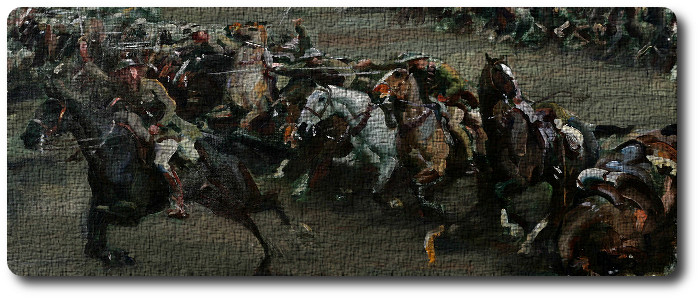
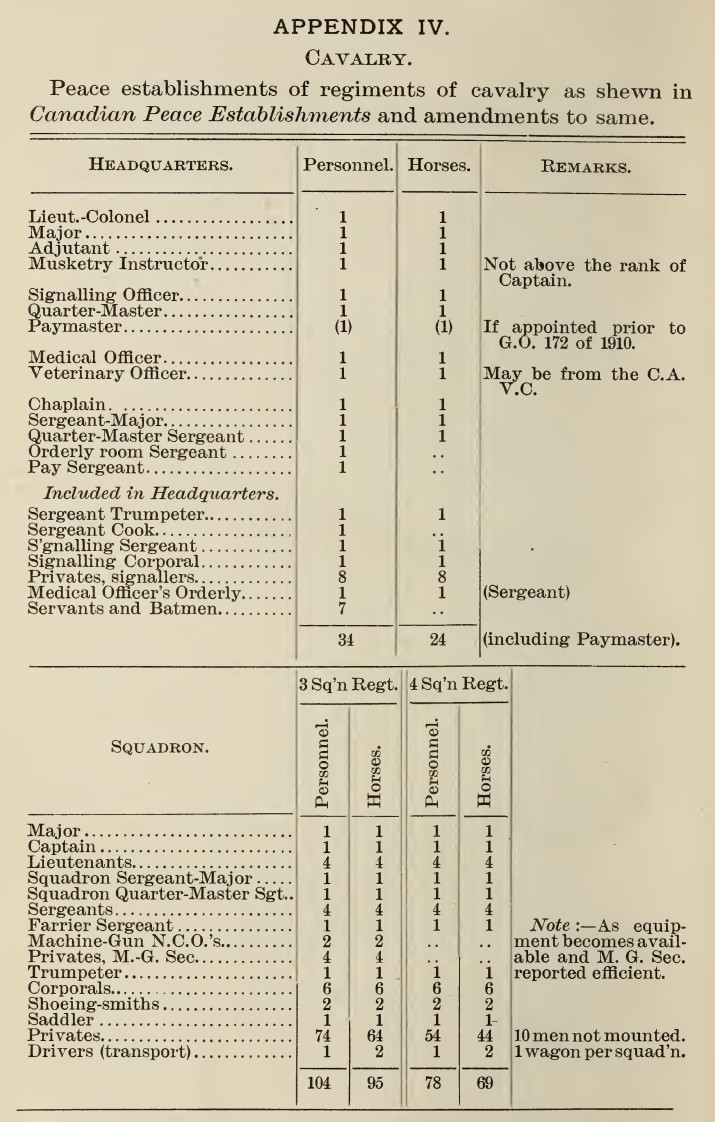

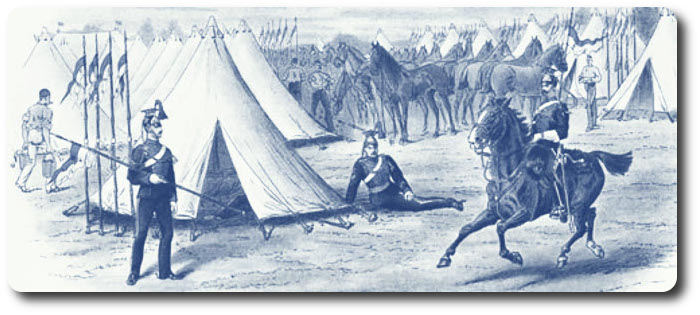
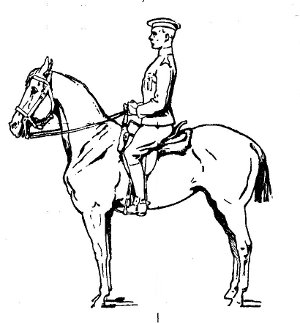 Cavalry.—The horse moves 400 yards at a walk, in about 3.9 minutes; at a trot in about 2 minutes; at a gallop in 1.4 minutes. His stride in walking is about 0.917 yards; at a trot 1.23 yards; at a gallop 3.52 yards. He occupies in the ranks 3 feet; in file 9 feet; in marching 12 feet. The heavy dragoon horse actually carries 270 pounds; if provided with one day's rations, 296 pounds, The light cavalry horse carries from 250 to 260 pounds, rations included. A cavalry horse should weigh about 1,000 pounds; height about 15.3 hands; girth round chest 80 inches. A day's rations for a horse is 10 pounds oats, 12 pounds hay, and 8 pounds straw in stable; 8 pounds oats, 18 pounds hay, 6 pounds straw, in billets; 32 pounds hay where no oats or bran are given; 9 pounds of oats are equal to 14 pounds bran. He will drink about 7 gallons of water daily. A horse should not be watered too early in the morning in cold weather. Horses' backs should be examined closely on saddling and unsaddling the least flinching should be taken notice of, and hot fomentations applied constantly. Kicks and contusions should be treated by hot fomentations, poultices, and cold water. A dose of physic may be necessary, depending on extent of tumefaction and pain. Sprains should be fomented; a dose of physic given, and cold water bandages applied. Cough and cold: soft diet, a fever ball with a little nitre; stimulate or blister the throat, if sore. If bleeding is necessary, rub the neck on the near side close to the throat, until the vein rises; to keep it full, tie a string round the neck, just below the middle; strike the fleam into the vein smartly, with a short stick. If the blood does not flow freely, the blow being properly struck, it may be made do so by holding the head well up, and causing the horse to move its jaws. After a march, first take off the bridles, tie up horses by headstall chains; loosen girths, turn up crupper and stirrups; sponge nostrils and eyes, and rub the head with a dry wisp; pick and wash feet, and give hay; wipe bit and stirrups. After the men have had their meal, saddles are taken off and the horses cleaned, watered, fed, and bedded. Upon the vigour with which grooming is performed, greatly depends the condition of the horse, when exposed to fatigue or exposure to the weather. Hand rubbing the legs and ears, not only till they are dry, but until the blood circulates freely, should be particularly observed.
Cavalry.—The horse moves 400 yards at a walk, in about 3.9 minutes; at a trot in about 2 minutes; at a gallop in 1.4 minutes. His stride in walking is about 0.917 yards; at a trot 1.23 yards; at a gallop 3.52 yards. He occupies in the ranks 3 feet; in file 9 feet; in marching 12 feet. The heavy dragoon horse actually carries 270 pounds; if provided with one day's rations, 296 pounds, The light cavalry horse carries from 250 to 260 pounds, rations included. A cavalry horse should weigh about 1,000 pounds; height about 15.3 hands; girth round chest 80 inches. A day's rations for a horse is 10 pounds oats, 12 pounds hay, and 8 pounds straw in stable; 8 pounds oats, 18 pounds hay, 6 pounds straw, in billets; 32 pounds hay where no oats or bran are given; 9 pounds of oats are equal to 14 pounds bran. He will drink about 7 gallons of water daily. A horse should not be watered too early in the morning in cold weather. Horses' backs should be examined closely on saddling and unsaddling the least flinching should be taken notice of, and hot fomentations applied constantly. Kicks and contusions should be treated by hot fomentations, poultices, and cold water. A dose of physic may be necessary, depending on extent of tumefaction and pain. Sprains should be fomented; a dose of physic given, and cold water bandages applied. Cough and cold: soft diet, a fever ball with a little nitre; stimulate or blister the throat, if sore. If bleeding is necessary, rub the neck on the near side close to the throat, until the vein rises; to keep it full, tie a string round the neck, just below the middle; strike the fleam into the vein smartly, with a short stick. If the blood does not flow freely, the blow being properly struck, it may be made do so by holding the head well up, and causing the horse to move its jaws. After a march, first take off the bridles, tie up horses by headstall chains; loosen girths, turn up crupper and stirrups; sponge nostrils and eyes, and rub the head with a dry wisp; pick and wash feet, and give hay; wipe bit and stirrups. After the men have had their meal, saddles are taken off and the horses cleaned, watered, fed, and bedded. Upon the vigour with which grooming is performed, greatly depends the condition of the horse, when exposed to fatigue or exposure to the weather. Hand rubbing the legs and ears, not only till they are dry, but until the blood circulates freely, should be particularly observed. 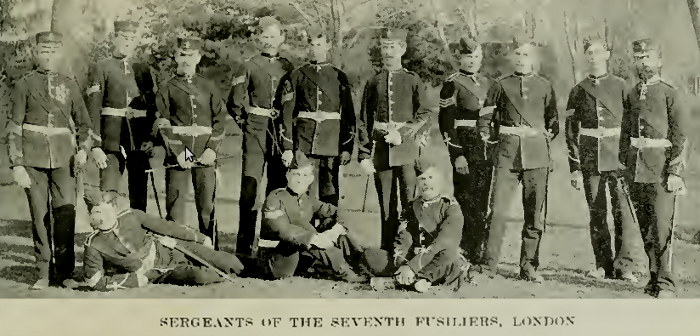



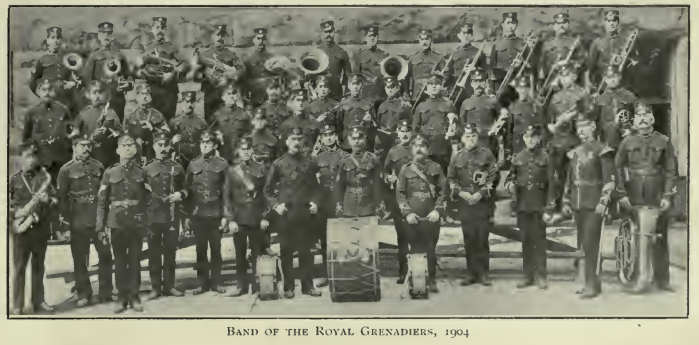

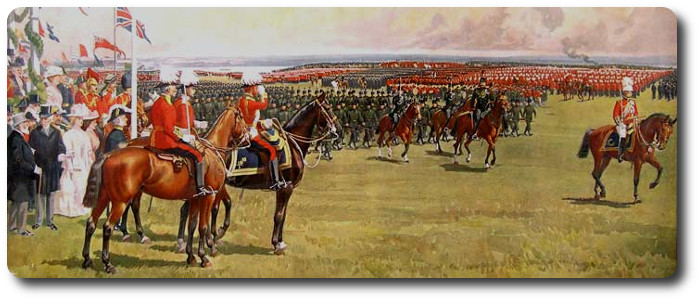


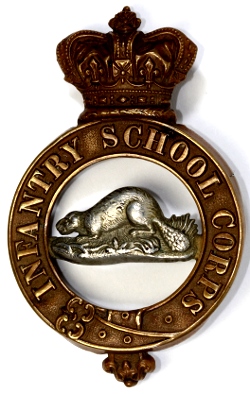 We do not wish to under-rate the value of the Royal Regiments of Canadian Regulars, but we do protest against making the object for which the schools were originally formed—the instruction of officers and men of the active militia—a secondary consideration altogether. The camp at Levis last autumn must have cost a good deal of money, and many militiamen asked themselves how it was the money could be forthcoming to hold a long camp for the benefit of the well-drilled men of the permanent corps, when the country can only afford to drill our rural corps, who need it badly, but once in two years, and not always that. Then, again, look at the parsimony practiced toward the city corps, who find it difficult to obtain from a grateful Government even the bare necessities of their equipment. Every officer of a city battalion has to contribute largely from his private means towards the support of the corps in order to provide the men with a proper head-dress and other articles, which the Government have overlooked or forgotten, as being necessary to enable men to turn out properly dressed on parade. And when the officers have gone to the expense of providing the men with the balance of their equipment, and spent money in having tunics made to fit them, the inspecting officer will find fault at the annual inspection, because, perhaps, one man is lacking some small article which the Government does not supply. What funny looking regiments would turn out in Montreal, if the men were dressed only in the uniform and accoutrements supplied by the Government.
We do not wish to under-rate the value of the Royal Regiments of Canadian Regulars, but we do protest against making the object for which the schools were originally formed—the instruction of officers and men of the active militia—a secondary consideration altogether. The camp at Levis last autumn must have cost a good deal of money, and many militiamen asked themselves how it was the money could be forthcoming to hold a long camp for the benefit of the well-drilled men of the permanent corps, when the country can only afford to drill our rural corps, who need it badly, but once in two years, and not always that. Then, again, look at the parsimony practiced toward the city corps, who find it difficult to obtain from a grateful Government even the bare necessities of their equipment. Every officer of a city battalion has to contribute largely from his private means towards the support of the corps in order to provide the men with a proper head-dress and other articles, which the Government have overlooked or forgotten, as being necessary to enable men to turn out properly dressed on parade. And when the officers have gone to the expense of providing the men with the balance of their equipment, and spent money in having tunics made to fit them, the inspecting officer will find fault at the annual inspection, because, perhaps, one man is lacking some small article which the Government does not supply. What funny looking regiments would turn out in Montreal, if the men were dressed only in the uniform and accoutrements supplied by the Government.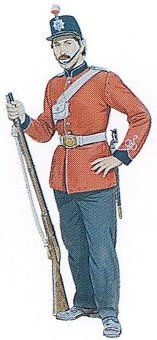 Should a company be warned for active service, the sergeant, whose duty it is to warn the men of his squad, shall be provided with a blank roll, the heading of which shall be as follows:
Should a company be warned for active service, the sergeant, whose duty it is to warn the men of his squad, shall be provided with a blank roll, the heading of which shall be as follows: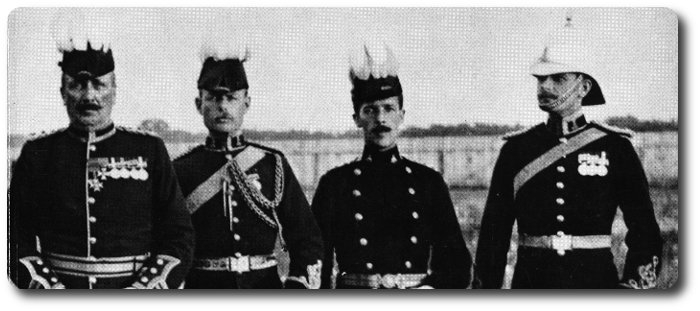
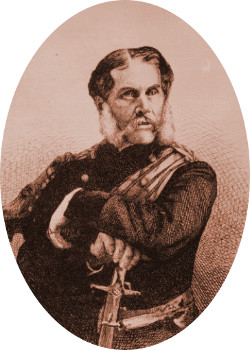 The report of the state of the Dominion Militia, presented by
The report of the state of the Dominion Militia, presented by 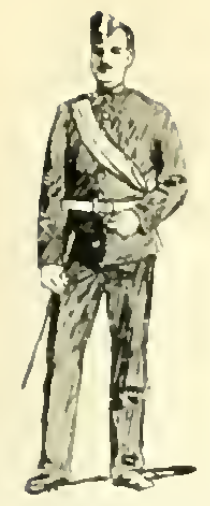 Another matter of special importance in the organization of the volunteer militia is the system by which men are enrolled. There is something radically wrong when we find from year to year that such a large proportion of the men are recruits. It is bit a very small proportion of the number of those that are enrolled that serve out their three years. A check should immediately be put on enlisting that unsettled class in the community that are here to-day and gone to-morrow. They only join with the object of getting a few days' pay and rations that are to be had at the period of the annual drills, having no love for the service at heart. They lower the tone of the rank and file, and hinder that esprit de corps which cannot be too strongly upheld. They are untidy and careless about their persons, and will do a uniform more damage in one season than a good man would do to it in three years. No decent man will wear a uniform after one of them. The expenditure of money and instruction upon them is a simple waste. Officers are naturally very eager to bring up the ranks to their proper strength at the period of annual drill, but the practice of filling them with these make-shifts should be discouraged, and none but men likely to serve out their full term should ever be enrolled. The men who do credit to the service are not those who join for considerations of pay, and en effectual means of shutting out those who would enroll from mercenary motives alone would be to make the pay progressive. Recruits should only receive 25 cents per diem, second-year men 50 cents per diem, and third-year men and over 75 cents per diem. This plan, if adopted, would guard against the enlistment of any but proper men. It would give to a three-year man the same total pay as if he had the 50 cents per diem each separate year, and after the three years it would be a reward to long service men, and an inducement to continue on in the service. A man after three years of instruction ought to be worth more than a recruit.
Another matter of special importance in the organization of the volunteer militia is the system by which men are enrolled. There is something radically wrong when we find from year to year that such a large proportion of the men are recruits. It is bit a very small proportion of the number of those that are enrolled that serve out their three years. A check should immediately be put on enlisting that unsettled class in the community that are here to-day and gone to-morrow. They only join with the object of getting a few days' pay and rations that are to be had at the period of the annual drills, having no love for the service at heart. They lower the tone of the rank and file, and hinder that esprit de corps which cannot be too strongly upheld. They are untidy and careless about their persons, and will do a uniform more damage in one season than a good man would do to it in three years. No decent man will wear a uniform after one of them. The expenditure of money and instruction upon them is a simple waste. Officers are naturally very eager to bring up the ranks to their proper strength at the period of annual drill, but the practice of filling them with these make-shifts should be discouraged, and none but men likely to serve out their full term should ever be enrolled. The men who do credit to the service are not those who join for considerations of pay, and en effectual means of shutting out those who would enroll from mercenary motives alone would be to make the pay progressive. Recruits should only receive 25 cents per diem, second-year men 50 cents per diem, and third-year men and over 75 cents per diem. This plan, if adopted, would guard against the enlistment of any but proper men. It would give to a three-year man the same total pay as if he had the 50 cents per diem each separate year, and after the three years it would be a reward to long service men, and an inducement to continue on in the service. A man after three years of instruction ought to be worth more than a recruit.